

Hakone Ekiden: Running Into the New Year
|
When one thinks of winter sports, surely images of skiing, snowboarding, and figure skating are what come to mind. However, did you know that one of the most popular sporting events that happens in the cold of the New Year is a long-distance relay?
The Tokyo-Hakone Ofuku Daigaku Ekiden (known colloquially as the Hakone Ekiden) is a two-day relay race that takes place every year on 2 and 3 January. Runners battle bitter cold winds and exhaustion as they run from the heart of Tokyo to the mountainous roads of Hakone and back, on a demanding course that spans a total distance of nearly 218km. (To put this distance into perspective, Singapore has about 193km of coastline, falling about 20km shy of the Hakone Ekiden’s course.) It may not be well-known outside Japan, but the relay attracts overwhelming interest from viewers all over Japan: spectators turn out in droves along the race course to cheer on the runners, and it also receives full television coverage nationwide, attracting viewership figures between 27-30%. The word ekiden (駅伝) comes from the words eki, meaning ‘station,’ and den, which means ‘transmit.’ It referred to an ancient system of relaying messages between places; people ran or rode horses between stations, to transmit goods and information. Now it is used to describe long-distance relay races that are held on roads. Ekiden are often compared to cross-country races, but the format of these sporting events are rather different. For example, ekiden races take place on roads, while cross-country races can have runners running on other surfaces such as grass and mud. Strategies for both events differ as well, with cross-country races focusing on running as a pack, while participants in ekiden-style races have to rely only on themselves for pace. |
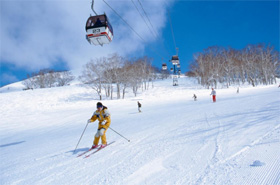 © Niseko Resort Tourist Association 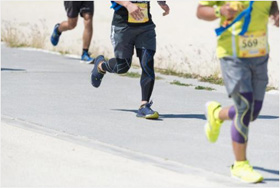 © photoAC 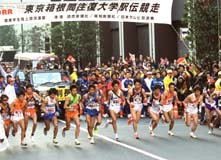 © Jiji |
|
The first of these ekiden races, the Tokaido Ekiden Toho Kyoso, was held in 1917: two teams of 23 runners each ran along the historical Tokaido road that connected Kyoto and Tokyo, following the same path that Japanese in the past took to relay messages on horseback. This particular ekiden took teams over 3 days to complete the race, which covered a distance of over 500km. Shizo Kanakuri, a marathon athlete and the first Japanese Olympian, was inspired by this race and went on to establish what we now know as the Hakone Ekiden. He had participated in the 1912 Stockholm Olympic marathon but was unable to finish the race. Disappointed by his lack of results, he returned to Japan and worked to raise the level of Japanese long-distance runners. In 1920, he persuaded students from universities in the Kanto region to participate in a ten-stage relay race that would take them from Otemachi in central Tokyo, up Mount Hakone, round Ashinoko Lake, and back down into Tokyo.
Unlike most relays, in which runners pass batons to one another, the students participating in the Hakone Ekiden run with a sash, known as a tasuki (タスキ), that hangs from their shoulder. These sashes display each team’s name and colour, and are passed from teammate to teammate after they finish their respective legs. The Hakone Ekiden’s rules state that teams that are more than 20 minutes behind the team in first place have to have their next runner start running their leg while the current runner is still running their own leg. This departing runner has to wear a different sash indicating they did not receive their team’s sash from his teammate. The act of passing the sash to the next runner is seen to have great symbolic importance, and so the runners strive to make it within the time limit so that the team sash can be passed on accordingly. Each leg of the race is demanding in their own way, and teams have to be strategic when assigning runners to each section. The fifth leg of the race is seen as particularly taxing, as runners have to run uphill as they approach their endpoint, Ashinoko Lake in the caldera of Mount Hakone. Runners that complete this leg with good times are often referred to as a “God of the Mountain.” Other legs have different challenges too - for example, runners challenging the downhill leg of the relay have to strike a balance between keeping a steady pace and keeping themselves safe; while it is easy to set records and take the lead while going downhill, they are also susceptible to injuries if they were to run too recklessly. Even in portions of the course where the road is mostly flat, runners have to stay strong against environmental conditions they cannot control, such as cold temperatures and strong winds. Although not as flashy as other New Year’s programmes, viewers are still drawn to the strong perseverance and athleticism displayed by the runners in the Hakone Ekiden despite how taxing the sporting event is. The emotions that run high during the competition, and the spirit of self-determination evident are themes that resonate soundly with many and such, the Hakone Ekiden is often portrayed in the media. The 2006 novel Run with the Wind by Shion Miura is one example of a piece of work that draws inspiration from the Hakone Ekiden. Its moving story which follows a group of unlikely novice runners training for the Hakone Ekiden received manga, anime, and live-action movie adaptations, and is popular not only in Japan but overseas as well. |
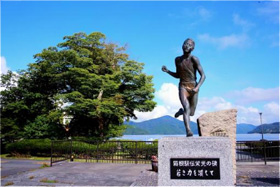 © photoAC 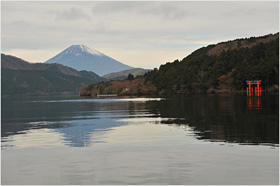 © Web Japan 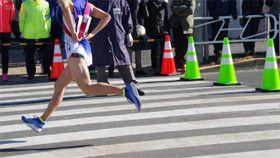 © photoAC 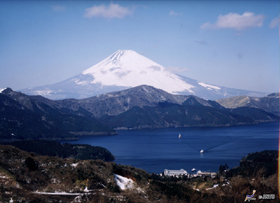 © JNTO  © photoAC  © photoAC |
|
Ekiden-style races, having originated in Japan, enjoy great popularity amongst the populace. Junior and high-school level competitors can take part in national championships during autumn, and adult teams have various meets they can join in the latter part of the year. However, out of the hundreds of meets available, the Hakone Ekiden reigns as the most popular and highly anticipated ekiden of all; with records constantly being broken with every iteration of the race, many athletes that take part can become celebrities in their own right.
For runners looking to challenge themselves in the New Year, why not gather a few like-minded friends and run your own ekiden? |
Resources
|
Carrick, B. (2011). Ekiden: A closer look at the Japanese way. Retrieved 23 December 2020, from https://www.espn.com/blog/high-school/track-and-xc/post/_/id/731/ekiden-a-closer-look-at-the-japanese-way |
|
Japan Creative Centre 4 Nassim Road, Singapore 258372 +65 6737 0434 / jcc@sn.mofa.go.jp https://www.sg.emb-japan.go.jp/JCC/ Nearest parking at Orchard Hotel & Delphi Orchard |
 |